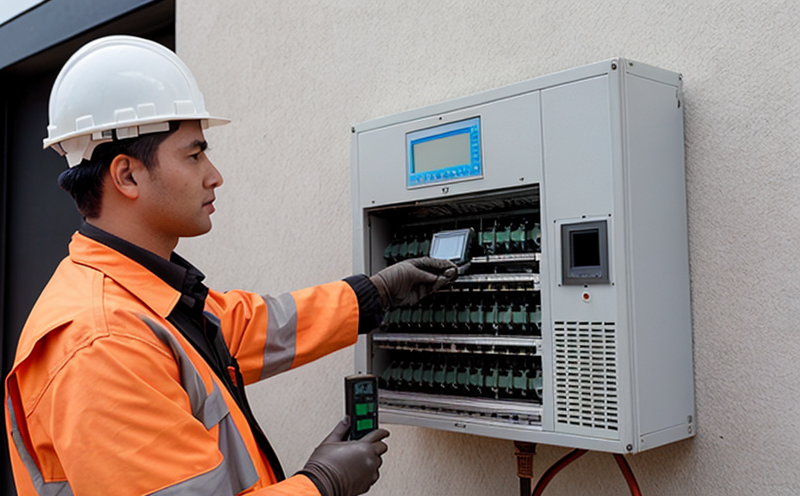Building energy management system inspection
The Building Energy Management System (BEMS) inspection is a critical component of ensuring optimal performance and compliance with international standards in the energy systems sector. A BEMS integrates various building equipment such as HVAC, lighting, and power distribution to manage and optimize energy consumption effectively. This inspection ensures that all components are functioning efficiently and adheres to the latest regulatory requirements.
The purpose of a BEMS inspection is multifaceted. It not only helps in reducing operational costs but also enhances environmental sustainability by minimizing unnecessary energy usage. By systematically monitoring and adjusting building systems, a BEMS can significantly improve occupant comfort while lowering greenhouse gas emissions. Regular inspections are essential to identify potential issues early on before they escalate into more severe problems that could lead to substantial financial losses.
During an inspection, several key aspects need careful examination. These include the condition of sensors and actuators which play crucial roles in data collection and system control respectively; wiring integrity ensuring there are no loose connections or exposed wires; software configuration making sure all parameters are set correctly according to manufacturer specifications; communication protocols verifying that devices can communicate effectively among themselves as well as with central controllers.
The inspection process involves a combination of manual checks and automated diagnostics. Manual inspections typically involve visual examinations using non-destructive methods like thermal imaging cameras or infrared thermometers to detect anomalies such as cold spots indicating inefficient insulation or hotspots pointing towards faulty equipment. Automated diagnostics leverage advanced analytics software capable of analyzing vast amounts of historical data collected by the BEMS over time, identifying patterns indicative of deteriorating performance trends.
One important aspect often overlooked is the impact on building occupants' well-being. Comfort levels directly influence productivity and satisfaction within workplaces or educational institutions. Ensuring a comfortable environment through precise control of temperature, humidity, lighting levels, etc., contributes significantly to overall employee health and safety standards. Thus, during inspections, attention should also be paid towards evaluating these factors alongside technical aspects.
Compliance with relevant international standards such as ISO 50001 for energy management systems provides a framework for best practices in reducing energy consumption efficiently across organizations worldwide. Adhering to these guidelines ensures that BEMS operations align seamlessly with global sustainability goals while maintaining high-quality service delivery.
Why It Matters
The importance of conducting regular inspections cannot be overstated when it comes to managing and optimizing building energy consumption effectively. Here are some key reasons why this practice is crucial:
Sustains operational efficiency by identifying and rectifying inefficiencies promptly.
Reduces maintenance costs through proactive identification of potential failures before they occur.
Promotes sustainable practices that contribute positively towards environmental conservation efforts.
Achieves regulatory compliance ensuring adherence to local and international laws governing energy management.
By focusing on these areas, businesses can achieve significant improvements in their overall energy management strategies leading not only to cost savings but also enhanced reputation among stakeholders.
Industry Applications
| Application Area | Description |
|---|---|
| Commercial Buildings | Optimizing HVAC systems in large office spaces reduces heating and cooling costs significantly. |
| Educational Institutions | Ensuring proper lighting levels in classrooms enhances student focus and learning outcomes. |
| Healthcare Facilities | Maintaining consistent temperature control in hospitals improves patient recovery rates. |
| Residential Complexes | Smart thermostats and lighting systems improve comfort levels while reducing monthly utility bills for residents. |
Across various sectors, a well-executed BEMS inspection plays an instrumental role in achieving desired outcomes. From enhancing operational efficiency to promoting sustainability initiatives, the benefits are vast and far-reaching.
Quality and Reliability Assurance
Adherence to strict testing protocols using industry-standard equipment ensures accurate results.
Data validation through continuous monitoring and analysis guarantees consistent performance metrics over time.
Quality assurance in BEMS inspections involves several steps aimed at maintaining high standards of reliability. First, all instruments used must be calibrated regularly to ensure precise measurements. Secondly, multiple data points should be collected from different parts of the building to verify consistency across all systems. Finally, detailed reports are generated after each inspection summarizing findings and recommendations for corrective actions where necessary.
Reliability assurance is equally important as it ensures that any issues identified during inspections will indeed persist even post-repair or replacement. This can be achieved by implementing follow-up visits at predetermined intervals to check improvements made against initial conditions recorded before the intervention took place.





